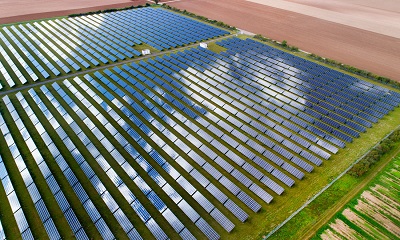 Wednesday, April 24, 2024
Wednesday, April 24, 2024  Wednesday, April 24, 2024
Wednesday, April 24, 2024 
Got news? Next submission deadline is Friday at 5:00 p.m.
Click here to submit YOUR news

Someday, solar panels may be light and cheap enough that they could be hung on a clothesline, thanks to a synthetic mineral called perovskite. Physicist Sam Stranks explains the solar-powered science and the challenges that stand in its way.
Solar power is key to our energy future. But the solar industry is butting up against one hard problem: Silicon cells are not very efficient at converting sunlight into electricity — at best, about 29 percent efficient. You may wonder, Why does efficiency even matter, when sunlight is free? The answer: because low efficiency means you need to install a whole lot of solar panels — which can be large, heavy and expensive to manufacture — to generate enough energy to make a dent in your needs.
But that could change thanks to a mineral called perovskite, according to Cambridge University physicist (and TED Fellow) Sam Stranks. He and his colleagues at Swift Solar are working to develop perovskite-based solar panels that could break the energy-efficiency upper limit.
What in the world is perovskite? The term “perovskite” refers to two substances: a calcium titanium oxide mineral composed of calcium titanate, and also the class of compounds that share the mineral’s unique crystal structure. The perovskites that hold such promising photovoltaic (PV), or solar energy-generating, properties are a group of human-made versions discovered in 2009 by Japanese scientist Tsutomu Miyasaka and colleagues. (Miyasaka was talked about in 2018 as a potential Nobel Prize recipient.) “These perovskites can absorb sunlight better than silicon,” says Stranks. “We can absorb almost all of the sunlight with a perovskite film that is at least a hundred times thinner than silicon.”
Scientists synthesize perovskites by mixing two inexpensive salts, lead halides and organic halides. This solution forms an ink, which can be applied in an ultrafine, uniform layer by using inkjet printing or spin coating. “The film deposited is very thin — around 500 nanometers or about 1/100th the thickness of a human hair — and it is enough to absorb a large fraction of the sunlight needed to generate electricity,” says Stranks.
The upshot: A little perovskite can generate a lot of power. “The state of California requires 50 gigawatts of power, for example,” says Stranks, “and to make enough solar panels, you’d only need half an Olympic swimming pool’s worth of perovskite ink.”
Watch the video and learn more about the benefits of joining Construction Links Network – the peer-to-peer network sharing platform for the construction, building and design community.
Ideal for YOUR Press Releases | Project Updates | New Appointments | Awards & Milestones | Company News | New Products/Services | Brochures | Videos | Infographs | Blog Sharing | Events and More